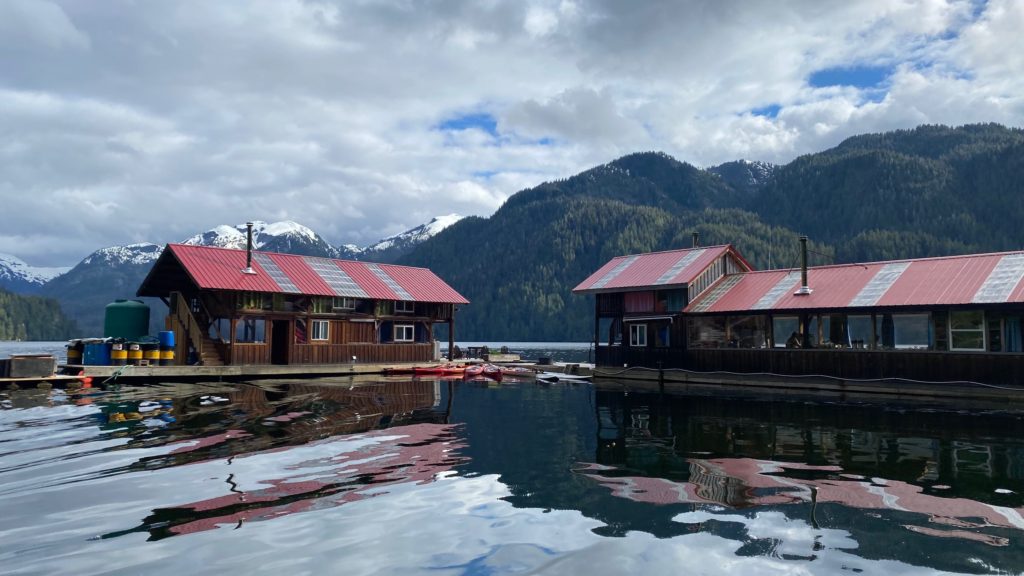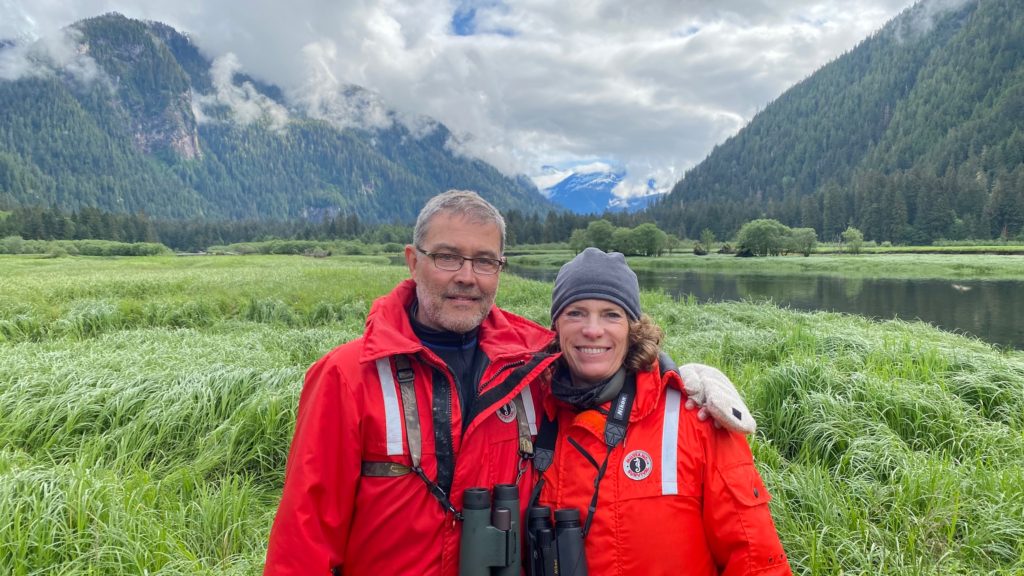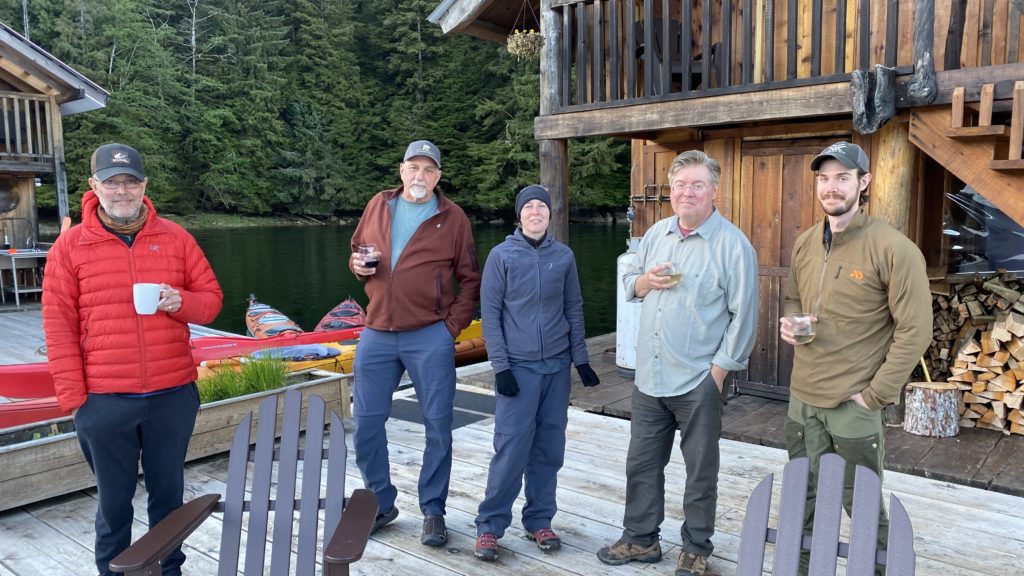I’m writing from a floating lodge in the Khutzeymateen Grizzly Bear Sanctuary in Northern British Columbia, quite close to the Alaskan border. We arrived yesterday via float plane from Prince Rupert to a lodge run by a small staff of mostly locals that can host 10 guests at a time for 3 day/3 night stays in this remote wilderness. When we left Vancouver on the flight to Prince Rupert, I could see out my window that the waterways around the airport and as we headed North were filled with logs, and more logs. As we flew over miles and miles of forested mountains to reach the depressed town of Prince Rupert, the mountainous forests were marred by clearcuts where the trees had been cut down and sent on to those waterways full of logs that I had just seen.
I mention this because as wonderful as the Khutzeymateen Wilderness Area is, it is a rare postage stamp of protected and unmarred habitat surrounded by the rest of British Columbia which is heavily marked by its human inhabitants and their natural resources economy. Decades ago, when John worked as a biologist in the salmon industry in this area, Prince Rupert was a happening town due to the fisheries. Now, they are all gone, along with the salmon. Only sport fishing is allowed now so Prince Rupert’s only major industry is its impressive port. As the proud little visitor center points out, it boasts the shortest route from North America to China by several hundred miles.
Our group at the lodge is all Canadians, other than me, but there are often international visitors. The common element is a desire to see the grizzlies up close and many guests are serious photographers as well. In our group, John and I are the only ones that do not have a camera with a humongous lens. We became accustomed to the machine gun click, click, click around us whenever we were stopped watching a bear.


The lodge is owned by Jamie, a man who has been living and working in the area for decades, including time overseeing the wilderness area for the parks service/BC government. Photo at left shows him pulling up Dungeness crab from a trap for our dinner. The traps are yielding much less now that the commercial crab season has started. Jamie’s unflappable personality and easygoing manner seem to be just the right approach to keeping a lodge operating and the staff and guests happy out in the middle of the wilderness, which is no mean feat. He bought the lodge rights a decade ago and rebuilt it to a level of comfort that works for most people – including a wood fired sauna, a dining building separate from the lodging area, and private bedrooms. His daughter, Chloe, who lives and works in Calgary, flew in with us to help out for a couple weeks so it’s somewhat of a family business.
Each day, there are two 3-4 hour bear viewing trips in a 32′ inflatable Zodiac. It’s been cold and often rainy, so we are grateful for our bright orange “floater suits” that keep us warm and dry. Jamie is our guide in the morning and Gerren, a gentle indigenous fellow of the Tsimshian nation from Lax Kw’alaams (a nearby indigenous village also known as Port Simpson), guides each afternoon. Gerren is a skilled spotter but so, it turns out, is John.

John’s childhood growing up amid African game parks in Uganda and Tanzania, and then eventually Nepal, clearly trained his brain to spot game of all sorts so on both of our wilderness trips, he frequently saw the wildlife first. If it weren’t for John, we would have missed the two wolves, one dark and one light, that he spotted on day two. He told me that he is ceaselessly scanning which is why he sees so much. This makes sense as I’ve always wondered how he notices animals that I would never see if he didn’t point them out. Aside from making me feel rather blind and unobservant, it’s a wonderful skill to have in a partner.

Many of the bears have been given names, from Alfie to Big Momma, and our guides can identify them becasuse they’ve known them since they were born. Most have become accustomed to the viewing, so they don’t run away when we are quietly watching from the water. The grizzlies spend 20 hours a day munching on sedge grass at this time of year to try and add back the 40% of their body weight they lost while hibernating during the winter. The Khutzeymateen is quite isolated with no roads or accommodations, and we saw only a few other viewers in boats. Even planes are not allowed to fly overhead, so it is largely undisturbed by humans.
Although grizzlies are large, dangerous, and sometimes vicious creatures, after spending three days watching them, they seem more like a cross between a cow and a teddy bear based on their laser focus on eating grass, their slow and loping movements, and the fact we did not see any altercations between bears that might have shown their other side. In addition to the grizzlies, we also saw the wolves and, from a distance, shaggy mountain goats. Harbor seals, sea otters, and jumping fish surrounded the lodge. Bald eagles are plentiful all over the area.

One of the challenges to this sort of travel, other than staying warm when it’s cold and wet, is that we are thrown together with a group of strangers with whom we spend a lot of hours per day as we are in the boat together for 6-8 hours and eat all meals together. Like the bears, each human has a distinct personality, with some easier to get along with than others. Our group is compatible, so we are lucky there isn’t anyone to spoil the mood.

Neil, the lodge chef, is another interesting character, of East Asian descent from the ski town of Revelstoke, BC. An experienced chef and apparently an amazing skier, he prepared three delicious meals for us per day including home baked bread, fresh Dungeness crab, and many creative soups, salads, and main courses. With opinions on politics, among other topics, he clearly likes the alternative lifestyle and freedoms that come with being a seasonal chef. He’s also been sommelier at a top hotel and has fed groups of Heli skiers during the winter at ski lodges. I caught him picking radishes out of his mini gardens before lunch one day.

At the end of our three days, the float plane takes us back to Prince Rupert and then we are off on our next adventure to the Queen Charlotte Islands, also known as Haida Gwaii. We have a 7-hour ferry ride to get there and once our tour starts, we will stay in another floating lodge while touring the cultural and natural attractions of the area including abandoned Haida villages. We look forward to getting to know another remote corner of BC’s west coast.